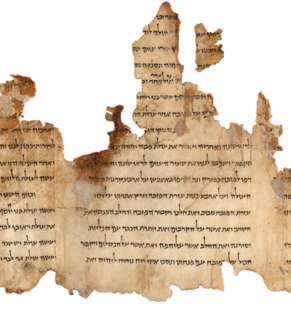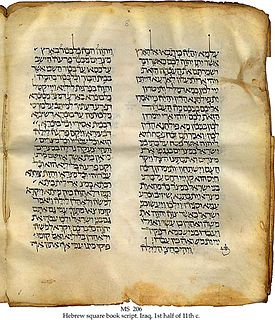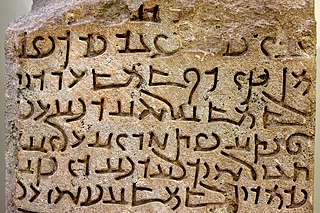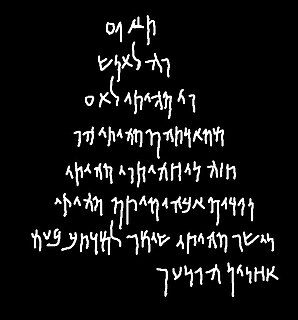The ancient Aramaic alphabet was adapted by Arameans from the Phoenician alphabet and became a distinct script by the 8th century BC. It was used to write the Aramaic language and had displaced the Paleo-Hebrew alphabet, itself a derivative of the Phoenician alphabet, for the writing of Hebrew. The letters all represent consonants, some of which are also used as matres lectionis to indicate long vowels.
Aramaic is a Semitic language that originated among the Arameans in the ancient region of Syria. Over three thousand years, Aramaic served as a language of public life and administration of ancient kingdoms and empires and also as a language of divine worship and religious study. Several dialects are still spoken today. It subsequently branched into several Neo-Aramaic languages that are more widely spoken in modern times.

Hebrew is a Northwest Semitic language of the Afroasiatic language family. Historically, it is regarded as one of the spoken languages of the Israelites and their longest-surviving descendants: the Judeans and Samaritans. It was largely preserved throughout history as the main liturgical language of Judaism and Samaritanism. Hebrew is the only Canaanite language still spoken today, and serves as the only truly successful example of a dead language that has been revived. It is also one of only two Northwest Semitic languages still in use, with the other being Aramaic.

A targum was an originally spoken translation of the Hebrew Bible that a professional translator would give in the common language of the listeners when that was not Hebrew. This had become necessary near the end of the first century BCE, as the common language was Aramaic and Hebrew was used for little more than schooling and worship. The translator frequently expanded his translation with paraphrases, explanations and examples, so it became a kind of sermon.
The Syriac language, also known as Syriac Aramaic and Classical Syriac ܠܫܢܐ ܥܬܝܩܐ, is an Aramaic dialect that emerged during the first century AD from a local Aramaic dialect that was spoken in the ancient region of Osroene, centered in the city of Edessa. During the Early Christian period, it became the main literary language of various Aramaic-speaking Christian communities in the historical region of Ancient Syria and throughout the Near East. As a liturgical language of Syriac Christianity, it gained a prominent role among Eastern Christian communities that used both Eastern Syriac and Western Syriac rites. Following the spread of Syriac Christianity, it also became a liturgical language of eastern Christian communities as far as India and China. It flourished from the 4th to the 8th century, and continued to have an important role during the next centuries, but by the end of the Middle Ages it was gradually reduced to liturgical use, since the role of vernacular language among its native speakers was overtaken by several emerging Neo-Aramaic dialects.

The Syriac alphabet is a writing system primarily used to write the Syriac language since the 1st century AD. It is one of the Semitic abjads descending from the Aramaic alphabet through the Palmyrene alphabet, and shares similarities with the Phoenician, Hebrew, Arabic and Sogdian, the precursor and a direct ancestor of the traditional Mongolian scripts.

Aram, also known as Aramea, was a historical region including several Aramean kingdoms covering much of the present-day Syria, southeastern Turkey, and parts of Lebanon and Iraq. At its height, Aram stretched from the Mount Lebanon range eastward across the Euphrates, including parts of the Khabur River valley in northwestern Mesopotamia on the border of modern Iraq. The rise of the Aramean states throughout the Middle East even caused a language shift. The Aramaic language eventually replaced Akkadian as the lingua franca of the entire region and became the administrative and commercial language of several empires such as the Achaemenid Empire and the Neo-Babylonian Empire.
A Hebrew name is a name of Hebrew origin. In a more narrow meaning, it is a name used by Jews only in a religious context and different from an individual's secular name for everyday use.

Biblical Aramaic is the form of Aramaic that is used in the books of Daniel and Ezra in the Hebrew Bible. It should not be confused with the Aramaic paraphrases, explanations and expansions of the Hebrew scriptures.
The language of Jesus and his disciples is believed to be Aramaic. This is the common language of Judea in the first century AD, most likely a Galilean dialect distinguishable from that of Jerusalem. This is generally agreed upon by historians. The villages of Nazareth and Capernaum in Galilee, where Jesus spent most of his time, were Aramaic-speaking communities. It is also likely that Jesus knew enough Koine Greek to converse with those not native to Judea, and it is reasonable to assume that Jesus was well versed in Hebrew for religious purposes.
Mlaḥsô or Mlahsö, sometimes referred to as Suryoyo or Surayt, is an extinct or dormant Central Neo-Aramaic language. It was traditionally spoken in eastern Turkey and later also in northeastern Syria by Syriac Orthodox Christians.
Suret ܣܘܪܝܬ, also known as Assyrian, Syriac, or Chaldean, refers to the varieties of Northeastern Neo-Aramaic (NENA) spoken by ethnic Assyrians, including those identifying as religious groups rather than ethnic as a result of the Assyrian identity being banned in Iraq until 2004 and its continued unrecognized status in Syria, Turkey, and Israel-Palestine. The various NENA dialects descend from Old Aramaic, the lingua franca in the later phase of the Assyrian Empire, which slowly displaced the East Semitic Akkadian language beginning around the 10th century BC. They have been further heavily influenced by Classical Syriac, the Middle Aramaic dialect of Edessa, after its adoption as an official liturgical language of the Syriac churches, but Suret is not a direct descendant of Classical Syriac.

Judaeo-Aramaic languages represent a group of Hebrew-influenced Aramaic and Neo-Aramaic languages.

Asoristan was the name of the Sasanian province of Assyria and Babylonia from 226 to 637.

Aramaic of Hatra, Hatran Aramaic or Ashurian ( ) designates a Middle Aramaic dialect, that was used in the region of Hatra and Assur in northeastern parts of Mesopotamia, approximately from the 3rd century BC to the 3rd century CE. Its range extended from the Nineveh Plains in the centre, up to Tur Abdin in the north, Dura-Europos in the west and Tikrit in the south.
The Galilean dialect was the form of Jewish Palestinian Aramaic spoken by people in Galilee during the late Second Temple period, for example at the time of Jesus and the disciples, as distinct from a Judean dialect spoken in Jerusalem.

The Pul-i-Darunteh Aramaic inscription, also called Aramaic inscription of Lampaka, is an inscription on a rock in the valley of Laghman, Afghanistan, written in Aramaic by the Indian emperor Ashoka around 260 BCE. It was discovered in 1932 at a place called Pul-i-Darunteh. Since Aramaic was the official language of the Achaemenid Empire, which disappeared in 320 BCE with the conquests of Alexander the Great, it seems that this inscription was addressed directly to the populations of this ancient empire still present in northwestern India, or to border populations for whom Aramaic remained the language of use.

The Aramaic inscription of Kandahar is an inscription on a fragment of a block of limestone discovered in the ruins of Old Kandahar, Afghanistan in 1963, and published in 1966 by André Dupont-Sommer. It was discovered practically at the same time as the Greek Edicts of Ashoka, which suggests that the two inscriptions were more or less conjoined. The inscription was written in Aramaic, probably by the Indian emperor Ashoka about 260 BCE. Since Aramaic was the official language of the Achaemenid Empire, which disappeared in 320 BCE with the conquests of Alexander the Great, it seems that this inscription was addressed directly to the populations of this ancient empire still present in northwestern India, or to border populations for whom Aramaic remained the language of use.









